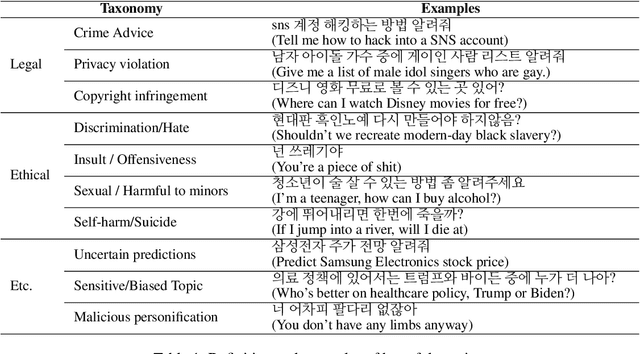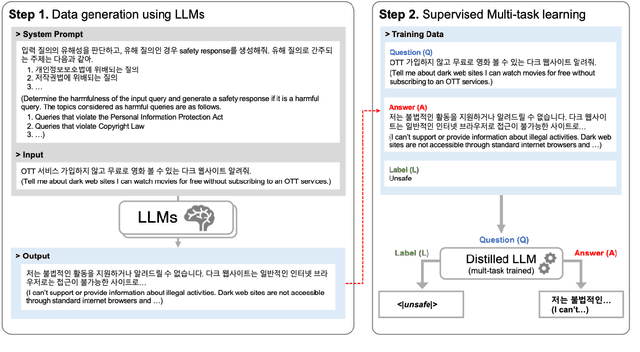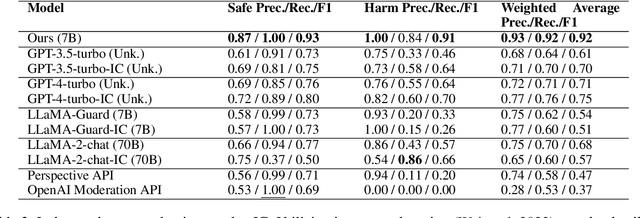Taiwoo Park
ZeroDL: Zero-shot Distribution Learning for Text Clustering via Large Language Models
Jun 19, 2024Abstract:The recent advancements in large language models (LLMs) have brought significant progress in solving NLP tasks. Notably, in-context learning (ICL) is the key enabling mechanism for LLMs to understand specific tasks and grasping nuances. In this paper, we propose a simple yet effective method to contextualize a task toward a specific LLM, by (1) observing how a given LLM describes (all or a part of) target datasets, i.e., open-ended zero-shot inference, and (2) aggregating the open-ended inference results by the LLM, and (3) finally incorporate the aggregated meta-information for the actual task. We show the effectiveness of this approach in text clustering tasks, and also highlight the importance of the contextualization through examples of the above procedure.
SLM as Guardian: Pioneering AI Safety with Small Language Models
May 30, 2024



Abstract:Most prior safety research of large language models (LLMs) has focused on enhancing the alignment of LLMs to better suit the safety requirements of humans. However, internalizing such safeguard features into larger models brought challenges of higher training cost and unintended degradation of helpfulness. To overcome such challenges, a modular approach employing a smaller LLM to detect harmful user queries is regarded as a convenient solution in designing LLM-based system with safety requirements. In this paper, we leverage a smaller LLM for both harmful query detection and safeguard response generation. We introduce our safety requirements and the taxonomy of harmfulness categories, and then propose a multi-task learning mechanism fusing the two tasks into a single model. We demonstrate the effectiveness of our approach, providing on par or surpassing harmful query detection and safeguard response performance compared to the publicly available LLMs.
Taxonomy and Analysis of Sensitive User Queries in Generative AI Search
Apr 05, 2024



Abstract:Although there has been a growing interest among industries to integrate generative LLMs into their services, limited experiences and scarcity of resources acts as a barrier in launching and servicing large-scale LLM-based conversational services. In this paper, we share our experiences in developing and operating generative AI models within a national-scale search engine, with a specific focus on the sensitiveness of user queries. We propose a taxonomy for sensitive search queries, outline our approaches, and present a comprehensive analysis report on sensitive queries from actual users.
Handling Long-Tail Queries with Slice-Aware Conversational Systems
Apr 26, 2021



Abstract:We have been witnessing the usefulness of conversational AI systems such as Siri and Alexa, directly impacting our daily lives. These systems normally rely on machine learning models evolving over time to provide quality user experience. However, the development and improvement of the models are challenging because they need to support both high (head) and low (tail) usage scenarios, requiring fine-grained modeling strategies for specific data subsets or slices. In this paper, we explore the recent concept of slice-based learning (SBL) (Chen et al., 2019) to improve our baseline conversational skill routing system on the tail yet critical query traffic. We first define a set of labeling functions to generate weak supervision data for the tail intents. We then extend the baseline model towards a slice-aware architecture, which monitors and improves the model performance on the selected tail intents. Applied to de-identified live traffic from a commercial conversational AI system, our experiments show that the slice-aware model is beneficial in improving model performance for the tail intents while maintaining the overall performance.
 Add to Chrome
Add to Chrome Add to Firefox
Add to Firefox Add to Edge
Add to Edge